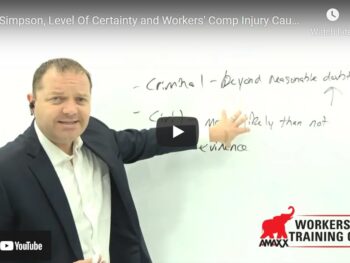A far-reaching ruling by the Superior Court of New Jersey Appellate Division could alter the divide between work-related injuries and personal medical conditions. In the case of James P. Renner vs. AT&T, two superior court judges, Cuff and Fasciale, agreed with the ruling of the workers compensation judge; a pulmonary embolism brought on by the requirements of the job is a compensable injury under New Jersey’s workers compensation statutes governing cardiovascular injury or death.
In the workers compensation claim, the claimant’s wife, Cathleen Renner, died from a pulmonary embolism. Renner was a salaried manager for AT&T and worked for the company for 25 years. She often worked from home and spent many hours in front of her computer to accomplish the projects and task assigned to her. She often worked all types of hours, day and night, even though she was officially a nine-to-five employee.
On the night of Sept. 24, 2007, Ms. Renner started working on a project from home. She told her husband by telephone that she had a deadline to meet and was going to work through the night. While AT&T and Mr. Renner dispute how long Ms. Renner worked that night, it is known that she sent an email to a coworker at 12:26 a.m.. When her son awoke at 7 a.m. Ms. Renner was at her computer working. At 9 a.m. she advised another employee that she was not feeling well, but would keep working to complete the project. At 10:30 a.m., Ms. Renner sent another coworker an email that she had finished the project. At 11:34 a.m., Ms. Renner called 911 as she was having trouble breathing. She died on the way to the hospital of a pulmonary embolism.
Death benefits for the workers compensation claim was denied by AT&T because a pulmonary embolism is a personal medical condition. Mr. Renner filed a claim with the New Jersey Department of Labor where the workers compensation judge applied the occupational disease standard and awarded death benefits. The Superior Court Appellate Division reversed and remanded to the workers compensation judge for consideration under the statutes governing cardiovascular injury or death. The workers compensation judge then awarded death benefits under the cardiovascular statutes and AT&T appealed again.
In the appeal, the doctor representing Mr. Renner testified that Ms Renner’s sitting for an extended period of time precipitated a slowing or stopping (stasis) of the blood flow which lead to the formation of blood clot in her leg. The blood clot eventually broke free, traveled to her lungs and resulted in her death. The doctor concluded that Ms. Renner’s sitting at her desk for a long period of time contributed to a material degree in her death. The doctor testifying on behalf of Mr. Renner acknowledged that the claimant had other risk factors including the use of birth control pills and obesity, but concluded since the blood clot was unorganized (per the autopsy report), it had developed during the time period she was working. The doctor further concluded that the blood clot developed five to seven hours prior to her death, as she had felt pain in her leg at approximately 7 a.m.
The doctor representing AT&T was of the opinion the pulmonary embolism was caused by the combination of risk factors the claimant had prior to her death. However, the AT&T legal expert acknowledged “it would certainly be less likely” for Ms. Renner to have a pulmonary embolism had she not been working that day.
The workers compensation judge had looked at whether or not Renner’s inactivity, which brought on the blood clot, was greater while working, than her inactivity while not working. Mr. Renner testified that Ms. Renner was always busy when she was not working including taking the kids to various school activities, always up and out, taking her mother to dinner, taking her mother-in-law to dinner, and transporting the kids to and from friends’ homes. It was concluded that Ms. Renner lead an active life when she was not working, but her job required her to spend unusually long hours at her computer and the blood clot developed as a result of her work inactivity.
The Superior Court Judges reviewed whether or not the workers compensation judge had properly applied the state statutes on workers compensation for cardiovascular causes. The workers compensation judge concluded the preponderance of credible evidence showed the death of Ms. Renner was caused by her work effort, which was in excess of the wear and tear of her daily living within reasonable medical probability. The superior court judges concluded the workers compensation judge had applied the law correctly.
The dividing line between what is a work-related disease and what is not can be difficult to define. In cases of this nature, it will often be the preponderance of medical evidence that determines whether or not work brought on the medical issue. For another look at idiopathic injuries, please also see our article, Idiopathic Injuries and Workers Compensation.
Author Rebecca Shafer, JD, President of Amaxx Risks Solutions, Inc. is a national expert in the field of workers compensation. She is a writer, speaker, and website publisher. Her expertise is working with employers to reduce workers compensation costs, and her clients include airlines, healthcare, printing, publishing, pharmaceuticals, retail, hospitality, and manufacturing. See www.LowerWC.com for more information. Contact: RShafer@ReduceYourWorkersComp.com.
WORK COMP CALCULATOR: http://www.LowerWC.com/calculator.php
MODIFIED DUTY CALCULATOR: http://www.LowerWC.com/transitional-duty-cost-calculator.php
WC GROUP: http://www.linkedin.com/groups?homeNewMember=&gid=1922050/
SUBSCRIBE: Workers Comp Resource Center Newsletter












